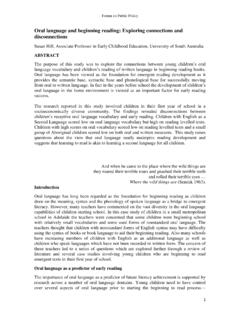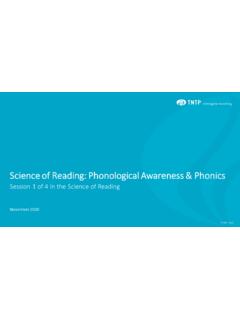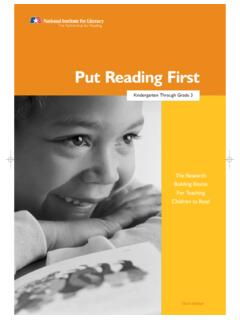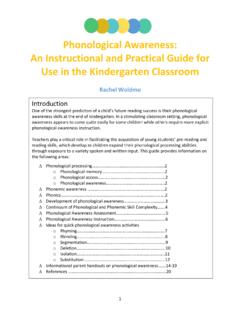Transcription of Components of Language
1 Chapter 5: Components of Language & Reading Chapter 5. The Components of Language and Reading Instruction Multiple references have been made in preceding chapters to the use of balanced reading instruction in studies of reading instruction. Prior to describing the Components of reading, an introduction to the Components of Language that shape that foundation is warranted. Components of Language Reading would not exist without the human capacity for Language . Because the Components of Language and their associated terminology align with our demarcations for many of the elements of reading, they are described briefly in this section. Linguists have identified five basic Components (phonology, morphology, syntax, semantics, and pragmatics). found across Language acquisition progresses across these Components with increasing quantity ( , sounds, words, and sentence length) and gradual refinement, and understanding of the subtler and more complex points of usage ( , using taught rather than teached ).
2 Readers are encouraged to explore the literature in the field of Language development to better understand and appreciate the oral Language skills students may bring to the reading process. Speech and Language pathologists are a great resource for identifying resources in this area and assisting in determining whether a child's Language skills are developing normally and providing support when assessment and intervention may be required. Phonology The study of speech structure within a Language , including both the patterns of basic speech units and the accepted rules of pronunciation, is known as The smallest units of sound that make up a Language are called phonemes. For example, the word that contains three phonemes the th represents one phoneme /th/, the a maps to the short a sound / /, and the t to its basic sound /t/. Morphology Moving to the next level of Language , we find the study of the smallest units of meaning, morphemes. Morphemes include base words, such as hat.
3 Dog, or love, as well as affixes, such as un-, re-, the plural s or es, . and the past tense ed. Knowledge of the morphology of our Language is critical to vocabulary development and reflects the smallest building blocks for comprehension. 41. Chapter 5: Components of Language & Reading Syntax The study of how individual words and their most basic meaningful units are combined to create sentences is known as syntax. As words are grouped together when we communicate, we must follow the rules of grammar for our Language , in other words, its syntax. It is the knowledge of syntax that allows us to recognize that the following two sentences, while containing different word order and levels of complexity, have the same meaning. The boy hit the ball. The ball was hit by the boy. Syntax also allows us to accept I went to the store as a meaningful (grammatical) sentence while To store went I would not be acceptable English. Semantics Not only does the grammatical structure of our Language provide the needed clues for understanding, we also have a wealth of figurative Language and rich description that adds color and nuance to our communication.
4 Semantics refers to the ways in which a Language conveys It is our understanding of semantics that allows us to recognize that someone who is green with envy has not changed hue, or that having cold feet has less to do with the appendage at the end of our legs and more to do with our anxiety about a new experience. Because semantics moves beyond the literal meaning of words and is culture-dependent, this is among the most difficult aspects of Language for individuals who are not native speakers and even those who speak the same Language but come from different cultures and convey meaning using words in unique ways. Anyone who has attempted to converse with a teenager in his own vernacular can appreciate the importance of sharing a semantic base for communicating clearly. Pragmatics Pragmatics' refers to the ways the members of the speech community achieve their goals using Language . 4 The way we speak to our parents is not the same as the way we interact with a sibling, for example.
5 The Language used in a formal speech may bear little resemblance to what we would hear at a lunch with five friends. The conversational style of day-to-day interactions is quite different from the Language used even when reading a 42. Chapter 5: Components of Language & Reading storybook to a toddler. Knowing the difference and when to use which style is the essence of pragmatics. Facility with Language is critical to social interactions. Our ability to effectively communicate with others through spoken and written Language is considered one of the ultimate goals of our educational system, with reading receiving much-needed emphasis. Reading is essential to success in our society. The ability to read is highly valued and important for social and economic advancement. 5 In the following section the Components identified by experts as critical to developing reading skills are reviewed. 43. Chapter 5: Components of Language & Reading Developing an Integrated Reading Program Effective and powerful instruction from knowledgeable teachers is the key to successful early reading achievement.
6 Balanced instruction providing all children with opportunities to master concepts of print, learn the alphabetic principle, acquire word recognition skills, develop phonemic awareness , engage in and sustain an interest in reading, and experience a wide range of materials in the context of developmentally appropriate instruction continues to be the major deterrent against reading failure (Adams, 1990; Hiebert, Pearson, Taylor, Richardson, &. Paris, 1998; Snow et al., 1998).6. The National Research Council Committee cautioned educators about use of the word balance proposing that integration is more appropriate. Balance does NOT mean dividing one's time equally among the Components of a comprehensive reading program, but, instead, developing an approach that is coherent and adjusts to the developmental reading needs of While the term balanced may be used more frequently, to reflect the NRC. Committee's suggestion, the term integrated will be employed in the current review of the critical Components of effective reading programs.
7 The consensus regarding the five Components described below evolved from the work of the National Research Council Committee and the National Reading Panel, which subsequently became the foundation for the Reading First initiative found in NCLB. Evidence regarding these Components is shaping state- and school-district decisions regarding reading program adoption as is clear in the list of accepted Reading First Programs. In many cases, it has significant financial and instructional implications. For example, it was recently reported that Anne Arundel County in Maryland was purchasing the Open Court reading series, which has a heavy phonics emphasis that has been promoted by reading experts and credited with rising test scores, including nearby Baltimore. The adoption would be an $8 million expense at a time when the district's budget was being cut by $13 million. Although concerns have been voiced that the program limits teacher flexibility, Arundel had begun implementing the program in schools with the lowest performance and reported that the curricular assessments indicated progress.
8 Also, administrators noted that teachers were reluctant when the program began, but were more accepting after working with the Effective implementation of reading programs is influenced by such fiscal pressures and educators' difficulty accepting change. 44. Chapter 5: Components of Language & Reading Instructional Components of Teaching Reading Quality instruction includes explicit explanations, modeling, and scaffolded practice that is engaging and meaningful meeting students where they are with respect to affect, motivation, and cognition; explicitly teaching them strategies for taking charge of tasks, situations, and personal styles; and scaffolding the successful completion of academic tasks. 9 While the full parameters for quality instruction cannot be included in this review of reading Components , we will incorporate as many as possible. Each of the Components will be described with several examples of how it may be integrated into reading instruction and, finally, how the component may apply to high-poverty/highly mobile students.
9 Phonemic awareness Phonemic awareness is one of the underlying Language skills considered highly predictive of later reading success. CIERA identified10. phonemic awareness instruction in kindergarten as closely related to emergent literacy skills. Some researchers suggest that the best predictor of reading difficulty in kindergarten or first grade is the inability to segment words into their sound Even among children with limited English proficiency, strong phonological awareness in their native Language was a strong predictor English reading Before describing this component in early reading instruction, it is helpful to recognize that phonemic awareness is a subset of phonological awareness . phonological awareness . Recall that phonemes refer to the smallest units of sounds, but there are other units of oral Language that are easier to hear and manipulate, such as words and syllables. The ability to hear and manipulate words, syllables, and phonemes is known as phonological awareness .
10 Children acquire the ability to identify and play with words and syllables before they can do the same with individual sounds. These simpler tasks are common preschool activities and the types of games that youngsters often play with their parents and other caregivers. phonological awareness , including phonemic awareness , does NOT involve written alphabetic letters or words. It focuses exclusively on oral Language . While some children who have difficulty hearing differences in sounds may benefit from the visual representation, this component involves prereading skills. The following tasks are samples of activities related to phonological awareness , starting with the skills that are mastered earlier and progressing in complexity. 45. Chapter 5: Components of Language & Reading Type of Task Description Example Rhyme Being able to match the Hit, pit, sit, lit, mitt ending sounds in words. (remember this is sounds, not letters). Alliteration Being able to generate Six, silly, squirmy, seals words that begin with the sang same sound.








